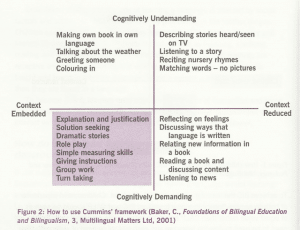CLIL morning with Junko Nichols, CLIL trainer from Victoria

On Monday morning 16th May 2016, the Chinese immersion teachers at Oberthur Primary School, Bull Creek, had a rare chance to pick the brains of a Language Consultant and CLIL trainer, Junko Nichols, from Melbourne. Other invitees to this exclusive event included Professor Rhonda Oliver, Director of Research at the Faculty of Education, Curtin University, Natalie Pearce, lecturer of Languages pedagogy at Curtin University and myself as a representative of the Perth CLIL (Content and Language Integrated Learning) Hub.
At the start of her presentation, Junko likened CLIL to a flower that with proper care and nourishment will flourish. Like a flower, it needs good foundations such as school support, professional learning and thorough planning, as well as encouragement, persistence and collaboration. She also revised the many benefits of CLIL such as quick acquisition of new language through real use, increased teacher collaboration, of critical thinking which are learning how to learn and metalinguistic skills.
Junko then reminded us of the basics of CLIL:
- The importance of dual focused learning, with equal emphasis on content (new skill or topic from a non-language learning area like Art or Mathematics) and language (the additional language used to teach the new content). The content must be new to the learners, not revision of a concept of skill already taught in English, and each session must also contain a specific language focus.
- Use of language for learning, of learning and through learning (“The Language Triptych”, Coyle, Hood & Marsh, 2010). Language of learning refers to the language required to understand the basic concepts and skills of the theme or topic. (The names of shapes for a Mathematics unit.) Language of learning is required to be able to engage in the learning process of any topic or unit. (“Could you please repeat that?”, “Please write this down”). Languages through learning is the unplanned language that emerges from the learning and cannot be predicted. As Natalie Pearce put it, “the magic bit”.
- The four C’s that need to be included in each lesson: Content (new learning), Communication (the language used as a tool to access the new learning), Cognition (learning must be cognitively challenging) and Culture (includes global citizenship).
- To activate and guide understanding, scaffolding and the use of visuals are Particularly useful are different kinds of mind maps as well as collaborative learning strategies (Kagan). Dale and Tanner (2010) list a number of useful CLIL activities: Placemat, Finish the sentence, Venn diagram, Timeline, Jigsaw reading, Think/pair/share, Y chart (feels like…/sounds like…/looks like…), Compare and contrast, Sequence of events, Cause and effect, Parts of a whole
- Content is the driver of CLIL lessons and decides the language needed. While planning a unit, the first step is to identify the concepts and skills to be taught and then the language required. While planning a CLIL unit, care needs to be taken to focus on the essential and simplify the new learning but not dumb down the curriculum.
- Gardners’ Multiple Intelligences and Bloom’s Taxonomy are important to ensure adequate differentiation and higher level thinking. Using a number of different activities also helps create multiple retrieval pathways, for instance through music. It was noted by Rhonda Oliver that John Hattie, amongst others, does not believe in the existence of multiple intelligences. However, he does emphasise that all students benefit from multiple ways of delivery and consolidation of new content, including using visual, auditory and kinaesthetic activities.
- Teacher talk needs to be simplified to Krashen’s “Comprehensible input plus one” i.e. one level up from 100% understanding. This ensures that students get the gist of the instruction but also have an opportunity to learn new words and expressions in context.
The focus of the second half of the session was assessment in CLIL, including assessment for learning (formative assessment). Just like in any other learning program, use of assessment rubrics is essential to make the learners aware of the intended goals of the program and enable them to assess their own or peers’ work against this criteria. A variety of assessment tools should be used, including portfoIios. It is also important to provide language and visual support for the assessment of content so that students’ lack of language skills does not mask the extend of their true learning.
When planning a CLIL unit, Cummins’ Quadrants (below) should be taken into consideration. The aim of any learning program is to move the students from the top left-hand quadrant to the bottom right-hand one. The challenge is move the students there though the remaining two quadrants, as a direct diagonal move is not possible. Traditionally, Languages programs have got stuck in in the top-left hand quadrant with no movement up or down over the years. CLIL is a fantastic way to get Languages students to the desired “context reduced, cognitively demanding” phase of Language understanding and use. Junko challenged all participants to consider where our current assessments fit in the Cummins’ Quadrant.

The most fruitful part of our session with Junko was to be able to address any challenges we have as CLIL educators. One of the main concerns was the limited time available to cover the curriculum in a second language. Junko advised to focus on the essential parts of the curriculum while keeping the learning cognitively challenging. She told a story of a Geography teacher in Victoria, who found his CLIL lessons to be more effective that his regular lessons in English. This teacher realised that when teaching in CLIL, he puts more effort into finding the essential learning in the curriculum and ensures that this is thoroughly understood by using mind maps and other visuals. He also admitted that while speaking in English, a lot of time was wasted on non-essential chatter or going off topic.
It is also common in CLIL classes to have long periods of silence, which many teachers find concerning. Junko assured us that this is the time when the students are processing the information and the real learning happens. She advised us to give adequate thinking time when answering questions, as it takes even longer for CLIL students to formulate their answers than students learning in their first language. Junko warned us about the use of English as means for instruction in our CLIL classes, even if it is for a short period or in the form of a Youtube clip in English. Use of English as a backup to ensure understanding is a slippery slide that undermines the whole purpose of CLIL and teaches the children to wait for the English translation. If you wish to show a video clip in English, turn off the sound and provide the commentary in the target language while taking advantage of the visuals of the clip. As Rhonda Oliver pointed out, L1 can support L2 but not replace it, and should only be used by students themselves clarify understanding and scaffold their learning, not by the teacher.
Finally, support was sought to deal with students who go home and tell their parents that “they cannot understand a thing”. Junko reminded us that it is rarely the case that students cannot not understand “a thing”, but the reasons behind these comments need to be investigated. It is important to educate the parents, as well as the students, as to what is realistic in a CLIL class, especially in the first years. We need to assure them that the program does work, with the benefits coming more and more visible as students continue with the program. In addition, CLIL classes need to have a culture where risk taking is encouraged and it is ok to make mistakes.
The morning with Junko Nichols was a wonderful opportunity for both the Chinese immersion teachers at Oberthur Primary School and the invited guests to get advice and support for their established CLIL programs. Most of the CLIL training in WA is for beginners, so the the chance to participate in an “advanced CLIL course” and ask questions from a CLIL veteran from Victoria was a rare treat for all participants. A big thank you to Immersion Program Co-ordinator Jieqi Zhang and Principal Tim Bamber at Oberthur Primary School for organising this event – and of course to Junko Nichols herself.
If you would like to join the Perth CLIL Hub mailing list and/or access a free online CLIL training module with footage from six CLIL classes in five languages (Japanese, Chinese, French, Italian and German), please email me on [email protected]
References and further reading:
Coyle, D., Hood, P. and Marsh, D. (2010) “CLIL: Content and Language Integrated Learning” Cambridge: Cambridge University Press.
Dale, L. and Tanner, R. (2012) “CLIL Activities” Cambridge: Cambridge University Press.

Leave a Reply